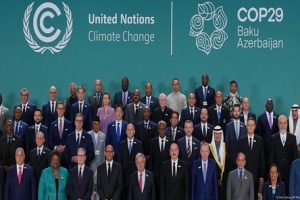
As the world becomes highly engaged in the hot agenda of de-carbonization which is threatening the global climate two things are also becoming important points of discussion. One is how to effectively exploit the huge volume of minerals required for replacing the carbon emitting sources of energy. The second one is preventing the possible ecological consequences that follow the unprecedented level of growing need to extract the mines.
The clean or carbon free minerals require minerals like lithium, graphite, cobalt and manganese in order to provide alternative source of energy. Africa is at the forefront of this agenda as it contains a huge reserve of these minerals.
“Yes, in Africa, we hold 30% of the global mineral reserves. The reason minerals are currently at the forefront is due to the de-carbonization agenda. With the energy transition that the world requires, there is a need for 6 times more exploration and exploitation to bridge the gap. This de-carbonization agenda specifically requires critical minerals, also known as green minerals, which are essential for technologies like solar panels, battery storage, and wind turbines. Many of these minerals are found in Africa – for example, 70% of cobalt is found in the DRC, lithium in Zimbabwe, and others in Ethiopia” says Marit KItaw (PhD) Interim Director of the African Minerals Development Center (AMDC), Specialized Agency of the African Union.
While agreeing on the need to speed up decarbonizations, some groups and experts in the field also argue that there is a need to make precautions from throwing the world into another cycle of ecological destruction in the process of rapid decarbonizing.
“They recouple Humanity with mineral extraction on a civilizational scale. Because in order to shift from fossil fuels to clean tech and in order to build the physical infrastructure and devices that support Wind turbines and semiconductors. Depending on the mineral, we need between 6 and 150 times. The current levels of production tell us that we will need 35 million tons of metals per year, for at least another 15 years, before we can move into a full circular economy” says Olivia Lazard, Research Fellow at Carnegie Endowment for International Peace.
“And here we run into several problems didn’t marsh artistic representation of copper extraction, illustrates the first 1 Extracting minerals can be very environmentally intensive and invasive, especially when ore concentration runs low. On average to produce 10 grams of copper with current Minds We need to move about 1 ton of soil.
According to Lazard it is important to consider the stakes and the risks in order to figure it out. The ecological costs of the energy transition and the digital transition have never been assessed. This needs to be fixed. Fixing it requires asking not just how much we’re going to mine Which may seem insignificant compared to the current levels of fossil extraction by today’s standards, she stressed.
Lazard advises that the costs inflicted on nature biodiversity, ecological services at local and National levels, therefore need to be priced and to extract a ventures and into industrial Partnerships. This is not a niche to have; it’s a matter of security. Failing to address climate stresses and water, stresses is already causing vast amounts of suffering and creating fundamental cracks in the ties that bind us all together within collective security systems.
Some of the Virgin deposits that investors are now considering correspond with those critical ecosystems. In other words, our Tech story Our industrial story is eating away at our natural story.
These ecosystems are but examples of ecosystems that are the Bedrock of life and the lifeline of planetary security, what this map, and these pictures should therefore bring you to ask a question is Are we designing a transition that strikes a necessary balance between Tech and nature?
And at a time when Tech is going into a narrative, a transhumanism, a new level of progress, redefining it as transgressing and conquering the boundaries of physicality. Are we funding and are we powering the right story to take us into the fourth Industrial Revolution? Or are we materializing the drivers of our own demise?
The researcher further argues that the Green growth and the fourth Industrial Revolution as it is currently designed is a story of plenty and Bounty built on scarcity and ecological exhaustion. We need to decarbonize fast. And we need to decarbonize well.
Decarbonizing well will entail using the questions that I mapped for you as guides for the last Industrial Revolution that we can implement Because it is the last one that will give us a potential at building economic fluxes that stay within planetary boundaries and aim to repair them as much as possible.
“Peace, Justice, economic, redistribution adaptation and regeneration provide us with maps Of the Global Commons to rebuild collectively” she reiterated. “And they’re not just the direction of travel. They are the building blocks of a transition that must be ecologically oriented and which geopolitical escalation is currently threatening”
Mining, purchasing ,digitalizing, virtualizing sends at the heart of the competition between China and the US, between Europe and Russia and between middle powers that are trying to essentially determine the outcomes of the fourth Industrial Revolution.
This competition is a driver of planetary overshoot and therefore planetary insecurity this competition risks repeating patterns of scrambling for resources and plundering ecology. It is the juncture where system change actors come in. We need to constrain certain types of action and accelerate others. And impact investors have a key role to play in Redefining economic trajectories for planetary security.
First of there is a need to build the future of security on the back of a regenerative packed that helps to balance Tech and ecology, Olivia elaborated. “That means no extraction without regeneration. This applies to Industrial actors and business models in areas of operations, in areas of extraction and purchasing between different extractive sectors and within industrial Partnerships that are currently in the making”
It also means taking complex regeneration. Seriously, we can’t plant trees to offset carbon emissions. The ecological Services need to be rebooted by redesigning what we call, water retention, Landscapes, at ecosystems level. We now have to take regeneration on a planetary and dynamic scale. This is a whole different ball game, which requires massive investments in cooperation Ventures. Investors will need to partner with those who understand the complexity of living systems starting with indigenous communities and their allies.
Second, Lazard notes that it is necessary to shed light on the ecological costs of the energy transition and Define where it is safe to mine, where it is not safe to mine and to build the infrastructures that are jointed to the mines. “We need to Define Nogo mining zones, zones that will need to be protected legally and compensated. Because the cost of not extracting, we also have to be compensated in the form of climate Justice”
On the basis of new estimates, for absolute quantity of ores available for the energy transition it will be possible to build a diverse coalition to bring about an international negotiation framework to deal with critical minerals as a global public good, according to her explanation.
“This will help to tackle demand and Supply Dynamics within a single platform. That connects mitigation and adaptation Pathways together along with biodiversity food and water Security”
BY ZEKARIAS WOLDEMARIAM
THE ETHIOPIAN HERALD TUESDAY 3 SEPTEMBER 2024





